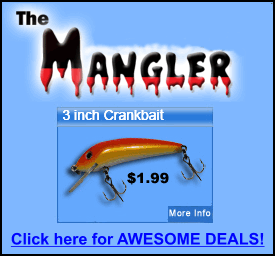|
  Hauling
Baits for Panfish Hauling
Baits for Panfish
By Tim Allard
Spring to autumn, panfish occupy a range of habitats from shallow
weed flats to deep, rocky structures. Casting has merits, but
there’s plenty of trolling methods that will pull big panfish
topside. Here are some popular strategies.
Propulsion Picks
I most often use an electric motor for trolling. It’s quiet,
well-matched for following lake contours, and delivers a lethargic
pace when needed. Controlled wind-drifting and a small outboard are
viable alternatives.
Fast Enough?
Trolling success relies on choosing an appropriate pace. This will
be species and mood dependent, but should always ensure panfish are
able to attack the bait accurately. Speed influences lure action, so
always check it runs properly at boat side before letting out line.
 Cranking
‘Em Up Cranking
‘Em Up
Hard-baits work in a variety of situations. Two to three inches is a
good average size. Straight and jointed minnowbaits are excellent
for skimming over cover for up-feeding panfish. Diving crankbaits,
such as a Rapala Shad Rap, pulled through mid-depth areas regularly
fool panfish from rock bass to perch. In pothole lakes, trolling
crankbaits beyond deep weed edges and along basin drop offs will
take suspending crappie.
Whirling By Weeds
A live-bait spinner rig’s streamlined properties make it a good
choice for probing plants. Tickling the top of vegetation or
skimming a weed wall will catch all sorts of panfish. Use a 1/4- to
1/8-ounce bullet weight on the mainline, followed by a bead for knot
protection, a swivel, and then a #2 to #4 Colorado or Indiana bladed
leader with a #4 to #8 bait hook. Sweeten the offering with a live
or artificial chunk of nightcrawler, a leech, or a 2- to 3-inch
minnow.
Working Jigs
Jigs are another viable trolling bait. Flat-lining’s the basic
approach for shallow water. Adding short twitches imparts a nervous
scurry that’ll trigger strikes. Soft-plastics, tied tinsel and hair
jigs all work but experiment to see if fish have a preference. For
flash and added vibration use a bladed model, like a Northland
Crappie Thumper Jig.
Floating Around
Presenting a jig beneath a float’s a good slow-trolling option. On a
recent outing it proved the best way to take crappie suspended high
around standing timber. Keeping a wide berth, I’d motor to the
wood’s mid-way mark, lob out a cast to the target, and then troll it
back into the strike zone. The float increased casting distance and
accuracy, served as a reference point to position the jig, and
signalled bites.
 Touring
Bottom Touring
Bottom
In summer and autumn deep bars and humps are hotspots for big
panfish. A bottom bouncer or a three-way rig dangling a bell sinker
are both options to plunge a bait to bottom while trolling. Run a
small minnowbait, spinner rig, plastic on an Aberdeen hook, or wet
fly behind these set-ups on a 30- and 48-inch fluorocarbon or
monofilament leader of 4- to 6-pound test.
Two’s Better Than One
Using two jigs is a common strategy for trolling deeper fish,
whether suspended or near bottom. Separate jigs cover more of the
water column but also allow experimentation to determine if panfish
prefer a particular profile or colour. To assemble it, tie the
lighter jig of the two to 18- to 24-inches of 6-pound mono on the
middle eyelet of a three-way swivel. Attach 30- to 38-inches to the
bottom eye, followed by a heavier jig to avoid tangles.
A further variation is adding a split shot half way down the bottom
lead. This allows two lightweight jigs to be trolled. The extra
weight keeps the presentation vertical in deeper water and permits
faster trolling. Check fishing regulations for hook-per-line
restrictions before using these rigs.
Map it Out
Regardless of presentation, plot a trolling route, ideally in a GPS
unit, before wetting a bait. A designated path allows precision
trolling around sweet spots, helps avoid hazards, and prevent
hang-ups. Use polarized glasses to locate healthy weeds and their
contours in shallow water. Map charts, like those by Navionics,
provide contour data for trolling deep structures.
Editors & Publishers
T.J. & Monique Quesnel
|
The
Ontario Fishing Network
E-Magazine is
published 12 times a year on or near the beginning of every month. Our
magazine is geared to any angler who enjoys fishing of any type in the
wonderfully diverse province of Ontario. Editorial Submissions: We welcome query letters,
but assume no responsibility for unsolicited materials. Subscriptions: Subscriptions are FREE of charge
and delivered via email.
You can subscribe
HERE: Privacy Policy: Unlike other publications We
NEVER make our subscribers list (your email address) available to any
other companies. Advertising: If you are interested in advertising
please email us. Circulation - 13,000 email subscribers
© 2011 Due North
Marketing / Ontario Fishing Network / T.J. Quesnel. All rights
reserved. Reproduction of any material without prior written
permission strictly prohibited. |
|